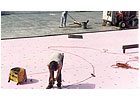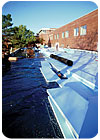

XPS can be a good choice for re-cover applications, where the existing membrane and insulation are left in place and new insulation and membrane are simply placed over the top of the old system. (Photo courtesy of the Extruded Polystyrene Foam Association.)
When it comes to insulation materials, there are many types of products to choose from when reroofing an existing structure. The function of roof insulation is to protect the building against heat flow (both in and out) and to provide a smooth, dry, clean and firmly attached substrate for the membrane. Proper insulation is necessary for energy efficiency, condensation control, and, in some systems, structural integrity against uplift pressure. One aspect of extruded polystyrene (XPS) is its long-term durability that can often make it reusable in reroofing situations.
All roofs leak over time and, as such, facilities may need to be reroofed two or three times during their service lives. When roofs leak, the intruding water often damages the insulation below the membrane. However, this is rarely the case with XPS due to its strength and ability to resist moisture. XPS retains its R-value, compressive strength, dryness, and integrity when the time comes for reroofing. (Because insulation formulation may vary from manufacturer to manufacturer, roofing professionals should consult the suppliers’ specification sheets to understand the exact properties over time, including the actual R-values. Factors affecting the R-value include thickness of application, the substrate, and the covering systems used.)
If the originally installed insulation maintains these critical properties, it is highly likely it will not need to be removed, transported to a landfill and replaced. The existing roofing membrane can be stripped and substituted with a new membrane, leaving the original XPS insulation in place. This translates into cost savings for the building owner in terms of both labor and new materials and can also divert materials from the waste stream, helping to preserve the environment.

XPS insulation’s excellent moisture resistance, stable long-term R-value, long-term durability and recyclability make it a top insulating material for commercial, industrial and residential structures. (Photo courtesy Dow Building Solutions.)
Avoiding Tear-Offs
XPS is also a good choice for re-cover applications, which is another form of reroofing. In this situation, the existing membrane and insulation are left in place and are simply re-covered with new insulation and new membrane. When old roofs are re-covered, the existing materials are left in place to dry, recouping some of their initial R-value. Also, the cost to remove the old system is avoided - this expense involves both the labor to remove the old system and the price of transporting the removed materials to a landfill.Tear-offs can become extremely costly when hazardous materials are discovered in the old assembly. Sometimes covering in place is the best option, rather than disturbing, containing and disposing of hazardous materials from older buildings. Contractors assigned to re-cover buildings should have the roof deck examined for structural and fastener integrity, the presence of a vapor retarder, and other aspects of drying potential, as well as required fire classification. Based on the inspection, if re-covering is a good solution, special XPS products designed for these applications can be a good choice for insulation.

When replacing the membranes on the insulated and ballasted roofing assemblies on four terminal buildings at the Dallas/Fort Worth (DFW) International Airport, nearly 90 percent of the existing XPS insulation was left in place. (Photo courtesy DFW International Airport.)
Sidebar: XPS' Extended Flight at DFW Airport
When the time came to replace membranes in insulated and ballasted roofing assemblies on four terminal buildings at the Dallas/Fort Worth (DFW) International Airport, everything old was new again.The project team looked for insulation under the rock ballast already in place and found perfectly reusable extruded polystyrene (XPS) insulation made more than 17 years ago. After sending samples of this extruded polystyrene (XPS) insulation to a laboratory to verify a lack of moisture and the appropriate compressive strength and R-value (the material retained 90 percent of the latter), the roofing consultant designed the projects to reuse as much of the existing XPS insulation as possible - nearly 90 percent of the old material.
This efficient use of resources allowed the airport to save thousands of dollars that would have been spent taking the old material to a landfill and replacing it with all new insulation. Labor for getting the old insulation off the roof and the price of new materials (including transportation) would have otherwise added thousands of dollars to the project.
There are also environmental benefits to being able to reuse the XPS. The strategy meant reusable material was not being sent to the landfill, and fossil fuel was not being consumed in manufacturing new insulation.
Report Abusive Comment